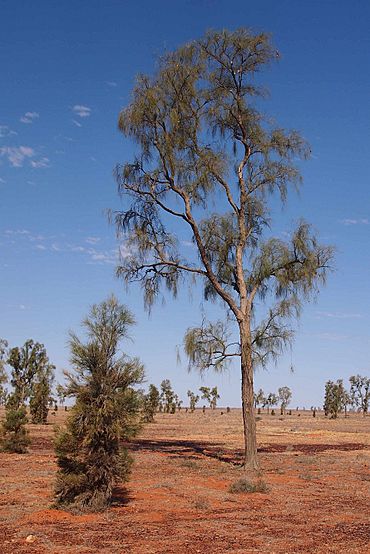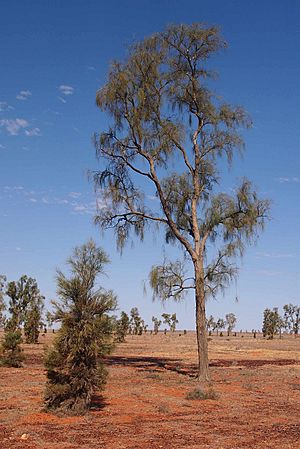Mac Clark (Acacia peuce) Conservation Reserve facts for kids
Quick facts for kids Mac Clark (Acacia peuce) Conservation ReserveGhan, Northern Territory |
|
|---|---|
|
IUCN Category IV (Habitat/Species Management Area)
|
|

Adult Acacia peuce tree
|
|
| Established | 1982 |
| Area | 30.42 km2 (11.7 sq mi) |
| Managing authorities | Parks and Wildlife Commission of the Northern Territory |
| See also | Protected areas of the Northern Territory |
The Mac Clark (Acacia peuce) Conservation Reserve is a special protected area in Australia's Northern Territory. It's found near a place called Ghan.
This reserve is about 130 kilometers (81 miles) south of Ltyentye Apurte Community. It's also about 290 kilometers (180 miles) southeast of Alice Springs. The land around it is a big cattle farm called Andado. The reserve is also on the edge of the famous Simpson Desert. A fence keeps cattle out to protect the plants inside. You can reach the reserve using the old Andado track or the Binns track. These tracks connect from Ltyentye Apurte Community or from Kulgera via the Stuart Highway.
Contents
Exploring the Reserve's Landscape
The Mac Clark Conservation Reserve covers about 3,042 hectares (7,517 acres). It is a flat, stony plain. This area is one of the hottest places in Australia. Summer temperatures often go above 40°C (104°F). The reserve gets very little rain, only about 150 millimeters (6 inches) each year.
History of the Land
Traditional Owners
The traditional owners of this land are the Arrernte peoples. They have lived and traveled through this area for thousands of years. The land holds many important Aboriginal artifacts. The name of the nearby cattle farm, Andado, comes from an Arrernte word. It means "stone tool."
European Settlement and Conservation
Europeans first arrived in this area in the 1880s. They began using the land for farming, raising sheep and later cattle. Malcolm "Mac" Clark and his wife Molly moved to Andado Station in 1955. Mac passed away in 1978. The reserve is named after him because he cared deeply about protecting the special trees found there.
Protecting the Rare Waddywood Tree
The main reason this reserve was created was to protect a very rare tree. This tree is called the Acacia peuce, also known as Waddywood. The reserve is home to about 1,000 mature Waddywood trees.
Why Waddywood is Special
During the 1900s, many of these trees were cut down. People used them to build shelters and cattle yards. This left only three groups of Waddywood trees in the world. One group is at Andado, another is near Birdsville, and the last is near Boulia.
The Waddywood tree is amazing because it thrives in a very harsh environment. Most other plants, like small shrubs and grasses, struggle to survive here. Waddywood trees can grow up to 17 meters (56 feet) tall. They can also live for a very long time, sometimes up to 500 years!
Threats to Waddywood Trees
Even though they are tough, young Waddywood trees face many dangers. Long periods without rain (drought) can harm them. Fires are also a big threat. Rabbits and livestock (like cattle) can eat the young seedlings. Scientists are studying the trees in the reserve. They want to learn how fast the trees grow and how well new trees are appearing.
Reserve Recognition
The Mac Clark Conservation Reserve was recognized for its importance in 1991. It was listed on the Register of the National Estate, which no longer exists. Later, on September 14, 1994, it was added to the Northern Territory Heritage Register. This helps ensure its protection for future generations.



